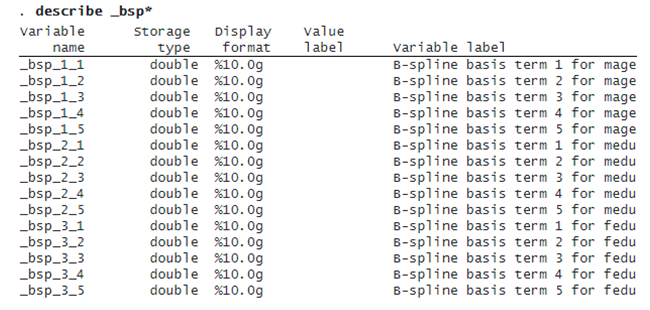SPLINE FUNCTION GENERATION IN ACTION!
We would like to see the effect of mothers smoking (mbsmoke) on an infant’s birthweight (bweight) using the telasso command. The telasso command lets us model both the outcome (bweight) and the treatment (mbsmoke). We believe that there is a relationship between birthweight and the mother’s age (mage), mother’s educational attainment (medu), and father’s educational attainment (fedu). We also believe that medu is a good predictor of whether a mother smokes during pregnancy.
We are agnostic about the functional form for the relationship of bweight and mage, medu, and fedu. We are also agnostic about the relationship between mbsmoke and medu. This does not matter to telasso. The command selects from a set of candidate covariates and estimates the treatment effect of interest.
We use makespline to form basis functions from each of the covariates of interest.
. makespline bspline mage medu fedu
We generated third-order B-spline basis functions, each consisting of five variables, from mage, medu, and fedu. The variables generated have generic system names, starting with _bsp. If you prefer, you can change the basis names using the basis() option. Below, we show the generated variables:

© Copyright 1996–2025 StataCorp LLC. All rights reserved.
The B-spline basis function components from mage start with_bsp_1, from medu with _bsp_2, and from fedu with _bsp_3. Using these basis functions, we fit the treatment-effects model:
. telasso (bweight c._bsp_1*##c._bsp_2* _bsp_3*) (mbsmoke _bsp_2*)
bweight is an arbitrary function of the interaction (specified by using ##) of the basis functions for mage and medu and of the basis function for father’s education. mbsmoke is an arbitrary function of the basis function for mother’s education. Below are the results:

The basis function variables created by makespline and their interactions produced 40 potential control variables. telasso selected 5 of those controls and used them to compute a treatment effect of –263 grams. In other words, the birthweight of babies would be 263 grams less if all mothers smoked relative to the counterfactual in which no mother smoked.

